The year was 2008, and I was participating in my first crochet-a-long. I wasn't designing yet - I was still very much in a learn all the things stage, having only discovered a few years prior that crochet was on the internet! And I found a year long afghan block crochet-a-long on Ravelry, and decided to join in and take my skills to the next level. It was a fantastic decision. I learned many techniques and stitches, and one of the things I quickly learned was how to adjust my squares to get them all to the target size!
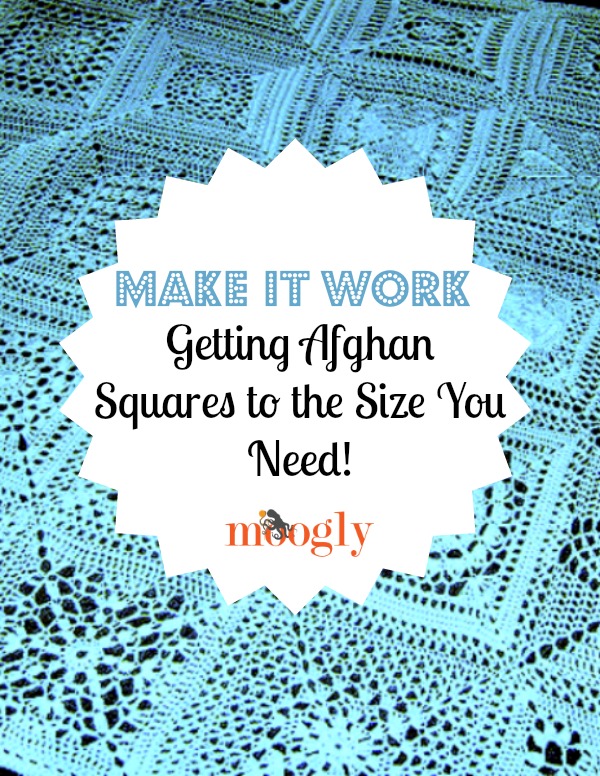
Whenever you make an afghan from blocks or squares, size becomes an important factor. Unless you're mixing small and large squares on purpose, you're going to want to get each square as close to the target size as possible.
But when making squares from different designers, that isn't always as easy as it might seem. Two designers might have both written patterns for 12" squares - but they might have very different tension levels. And when the same person makes both, they end up with one square that's 13" wide, and another that's only 10.5". Luckily, this is easy to fix - without frogging the whole square! Just make sure never to cut your yarn before you measure!
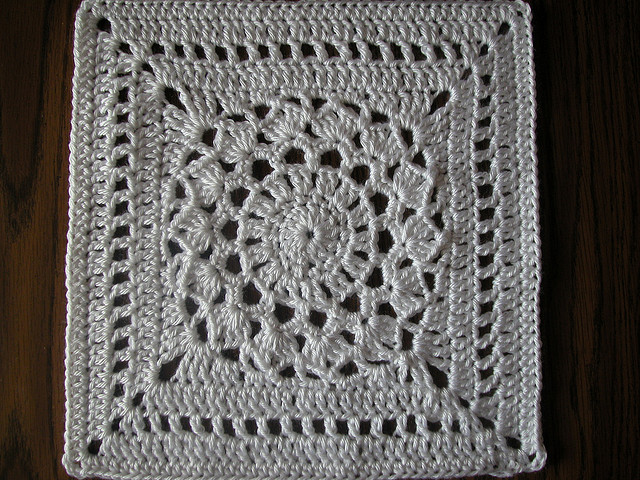
Above you see the square I made several years ago, using the pattern Flower Burst Square by Chris Simon. When I made this square according to the written directions, I came up an inch short - only 11" wide. But rather than frog the whole square and redo it with a larger hook, I just added an extra round of half double crochet stitches - and got to 12" exactly!
In my experience, a round of double crochet will get you over an inch of extra width, half double crochet about an inch, and single crochet a bit less than that. But that's my tension - you'll want to take your own measurements. So if you get to the end of a square, and need an extra row (or two!), try a few stitches and then take out the ruler. Measure the height of that last row, and then double it. Add that to your current width, and continue or adjust the stitches as needed!
But what if the square is too large? Then in that case, yes, you're probably going to want to undo, or frog, some of the stitches. But not the whole thing! If the last row is primarily double crochets, then pull that row out and sub in half double crochets, or single crochets. Or leave it off all together if needed!
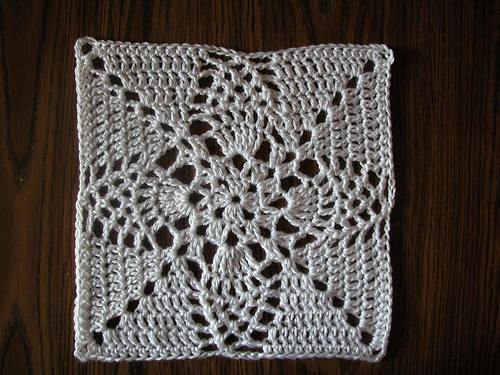
Personally, I like to measure as I go. For instance, the above picture is my version of the Pineapple Granny by Priscilla Hewitt. As I approached the end, I found that I was very nearly at 12" already, and wouldn't have room for the last row of double crochet. So I did it in half double crochet instead, and it worked out fine!
So with this post I want to encourage all of you participating in the 2014 Moogly Afghan Crochet-a-Long (as well as all of you who aren't!) to not fret if your squares don't all turn out at exactly 12" as written. Over the course of the year we'll be making patterns from many different designers, and while I've focused on 12" squares all made with the same weight yarn and hook size, it's pretty much guaranteed that some will measure up for some better than others.
And that's okay! Adding or subtracting, or substituting rows at the end of the square is all part of making a mixed squares afghan. It's okay if yours is a little different than the next person's - crochet is an art, and everyone's art is unique!


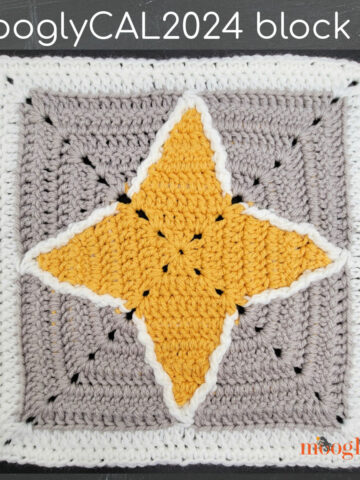
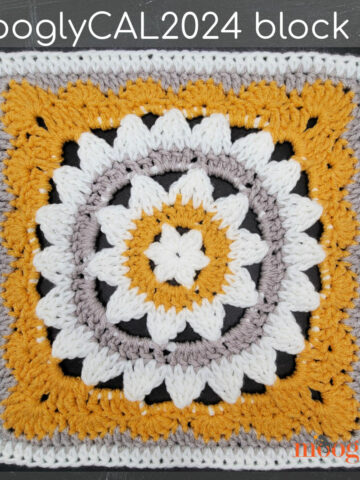
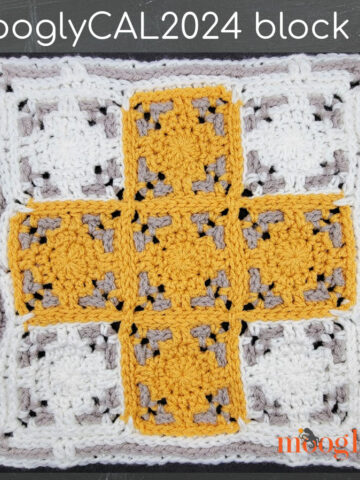

rachel
Perfect - thanks for the info!
Lori
Great tips! Thank you! I really like what you said about everyone's art is unique. Sometimes I get so caught up in exactly duplicating a pattern that I forget it's OK to just improvise and do it how I like or however it works for me. That said, since my first square in the 2014 CAL turned out to be about 13", I'm going to be adding lots of extra rows to the remaining squares and have an extra-large afghan at the end. And I'm OK with that - it's my unique art 🙂
Tamara Kelly
Great solution Lori! 😀 And thank you!
Betty Plemmons
This is a great article! Thank you for sharing 🙂
Albertine
This is so useful! But I do have a question. When 2 squares are both 12", does it mean that they will have the same amount of stiches? Or do you decrease or increase (cheat) in the second last row, so that the last row has the same amount of stitches? I'm very picky about that 😉
Tamara Kelly
Unless they're all of a set from the same designer, you'll have different stitch counts for the last row. There are ways to work around that in joining though! I'll be writing more about that later in the year when we're closer to joining them. 🙂
Pam
Hi Tamara, wondering if you posted directions about squares with different stitch counts and how to go about joining them anyway.
Tamara Kelly
Hi Pam! I've been working on a post about that for some time - it's a simple idea, but once I started writing about it, I just kept going. I hope to have it ready for publication soon!
Angel
Hey Tamara,
When I first saw your CAL post the other day, the first thing I thought about was how hard it would be to keep the square sizes uniform, because of a previous experience.
I made a throw recently where each granny square was a different design. They were all from the same pattern book, so the last row of each square had the same stitch count, which was a great plus. But, since I was using a different solid color for each square and some of the yarn brands were different, I had a problem with the squares coming out different sizes. I realized the problem quite early on and I adjusted the squares using different hook sizes and changing the stitches on some of the rows as you just suggested.
I did pull out many stitches, though. I would rework rows on some of the squares multiple times. I probably could have made three throws in the time it took me to make that one. (LOL) I didn't want the last row stitch count to be different, so I didn't want to just leave a row off. I was able to use the same stitch and hook size for the border row on all the squares, because I did those with white. That helped with assembly.
I am curious to know how assembly will be done on the CAL. Will all the squares come from different designers? If so, how will border stitch counts be accounted for when assembling at the end?
I am looking forward to see the next square.
Angel
Tamara Kelly
Everyone is free to use their own assembly methods, though some will work better than others. I plan on writing a lot more about joining once there are a few more squares, later in the year when it becomes more of an issue. Since they're all from different designers and different designs, there will be different stitch counts on the last row. What it boils down to, though, is that you have to get creative, just as you do when getting a square to size. And by creative, I mean fudge it a little. 😉
Cheryl Thoms
Thank You for the GREAT information. I have tried before to make everything the EXACT same size and nearly lost my mind. This is the perfect information I needed to keep me from frog frog frogging so much. 🙂
Debbie D.
I want to thank you for your blog and for taking the time to share with so many your talents, ideas, and patterns. I really appreciate it!
Tamara Kelly
🙂 Thank you Debbie!
Jasmine
Thank you for sharing..
I love your blog and love your work.
Mari
Hi! Thank you for your advice, this was really helpful! I got so excited of the project because I've never made an afghan and don't have the perseverance and the patience to do it, but I'd love to have one made by myself. This project is the perfect way for me to accomplish it! Thank you for organizing it 🙂 One question though, I'm not that familiar with inches and such, so does a 12" square mean that the one side of the square is 12" (= 30 cm) long? Sorry for the dumb question but I started to wonder since the squares are going to very large if they are 12" per side. And my first is not even close.. although I can always make a smaller afghan with smaller squares 🙂
Ps. You have a wonderful blog!
Tamara Kelly
Thank you Mari! Yes, a 12" square is 12" (30.48 cm) on each side. They are large, but that way you can get a nice size throw with only 24 squares. 🙂 I'm guessing you're in Europe, and might be using DK instead of worsted/aran weigh yarn? That would be one possible reason why your square is smaller. Either way, you can certainly make them smaller, it's just a matter of trying to get them all about the same size - which if you're consistent in yarn weight shouldn't be too hard. 😀
Mari
Thank you for your answer! Yes I am in Europe, but I have to admit that I don't really know about yarn weights. I now of course when I see some yarn if it is about the same weight with another yarn, but the names like worsted/aran weight or DK are weird for me. But it doesn't matter, I just use the same weight yarn throughout the project and it'll be fine, and the yarn that I used for my first square is a very very basic yarn in my country (Finland) so I'm going to get it 100% sure all year long 🙂 I don't mind getting a little smaller blanket and I'm very capable of adjusting the squares to the right size 😀
Tina
Can you do a review of the best way to sew in ends? I did a granny square afghan with lots of blocks, and the blocks are already unraveling.
Tamara Kelly
Hi Tina! I have a video tutorial about that here: https://www.mooglyblog.com/weaving-in-ends-crochet-video-tutorial/ 🙂
Tina
Thanks!
Penny
Great tips! Thanks!
Kris
I'm glad you posted this, I was a bit worried that my squares wouldn't turn out to be 12". I'm so glad I found your blog, it's great! I like that you post a lot of smaller projects that are faster to finish.
Tamara Kelly
😀 Thanks Kris!
Betty
Accidentally fell onto the crochet along Anticipation 12" square afghan. I'm excited to be part of a crochet community and start the project. My question is, how many squares are typically made of a single design? Also, how much yarn should be bought to insure you have enough for the entire project?
Tamara Kelly
Hi Betty! I'm making just 1 square of each design - there will be 24 squares total, to make a 4'x6' throw. If you want a larger blanket or to make multiple blankets you'll make multiples of course. I don't have an exact total, but the average square takes 150 yds or less and you'll want more for joining and borders. 🙂
Teresa
Hi Tamara!! I just started crocheting in November and I'm excited to learn with this CAL. I finished all of the rounds of the first square and my square is 10.5". I was going to add a row of hdc or dc to make it wide faster but I don't know how to do the corners with those stitches. Round 18 had three different stitches to make it "square" so I assume I cannot just do one stitch all the way around. Thanks!!
Tamara Kelly
Hi Teresa! For the corners here I'd either work 3 dc in each corner (if making dc sts), or maybe 2 dc, ch 1, dc in each corner. Try both and see which one you like best! 🙂 With an inch and a half to go, dc will probably work better than hdc.
Fran noerr
Thank you for the great info! Much appreciated.
jo margaret johannessen
THANK YOU SO MUCH FOR ALL YOUR HINTS AND TIPS ON HOW TO GET THE BEST OUT COME WHEN WE HAVE FINISHED THE BLOCKS AND FINIALLY SEWN THEM ALL UP .
GEE IT LOOKS SO GOOD OVER MY BED, BUT I AM PACKAGING IT UP TO SEND TO MY MOTHER IN LAW IN ACCRA, GHANA, WEST AFRICA,
I PRAY MARGARET WILL LOVE IT AS MUCH AS I DO.
AGAIN THANK YOU. FROM YOUR FREATFULL FOLLOWER IN VICTORIA AUSTRALIA.
Tamara Kelly
Thank you so much Jo Margaret! <3 I'm sure she will!
Mindy
Thank you so much for these tips! Your 2015 CAL is the first one I've taken part in, and looking at the first block I see I have a lot to learn. I will definitely be sure to measure as I go along so that my first CAL afghan isn't all catawampus. (I love it when I can throw that word into a conversation, lol.)
Tamara Kelly
😀 I hope they help! I know I learned a LOT my first CAL, and I've learned more in each one since!
Payricia Hale
thank you for this blog . I appreciate the encouragement and invites. It is helpful for us all to know that there are ways to correct this.
Kim Shepherd
Hi, first, my email is supposed to be all lower case, but it wouldn't switch over - just in case you were going to email me the answer. Second, love the look of the first block, really anticipating the crochet BUT what weight is worsted? I have had disasters before from using the Australian equivalent (8 ply) is the yarn used a ten or twelve ply? Any idea at all? Hoping you can help me out here. Thanks
Tamara Kelly
Hi Kim! No worries about the email - email addresses aren't case sensitive. 🙂 I'm glad you like the block! In Australia, our worsted is equivalent to 10 ply. Here's a chart that might come in handy: http://www.crochet-knit.com/yarn_conversion.html Of course, you can use thinner yarn and a smaller hook for smaller blocks if you like. I believe last year lots of UKers used DK, or 8 ply, and made 10" blocks instead.
Ann Graham
Tamara, Here we are in 2018 and still more questions.! Last year when I completed squares they were mostly 13" so I made all of them that size. This year I am a better crochet-er. Or my hook is allowing me to do a better job. Anyway, when I get to then end and I lay down a ruler on the square, it is usually 10.5. (using Red Heart regular weight yarn). Since I am doing the wet-block method of blocking, I have not been adding any more rows, but instead have just stretched the squares to get 12". Is that correct? or should I be aiming for them to be 12" with a ruler laying on top of it, dry, as soon as I am close to being done?
Love doing these CAL squares! Thanks!
Tamara Kelly
Hi Ann! The most important thing is that the squares all end up the same size. If you block them all to 12" and they stay there, then you're fine! If they are shrinking up again when you take them off the blocking pins/board/etc, then you can decide to keep them all 10.5 or add rows - it's up to you! 🙂
I'm so glad you're enjoying them! Thank you! 😀
CECILIA
It helps if the designer gives some sort of gauge or measurement so you can check as you go along, before you do the entire square and find out you're way off. In block 2, Garden Gables, of the 2023 CAL, Kim Guzman wrote: after round 4, the measurement across is about 4″ and after round 8, the measurement is about 7.5″. I had started with an I hook as I tend to crochet loosely, but after round 8 I was well under 7.5". So I switched to a J hook to finish and came out exactly right.